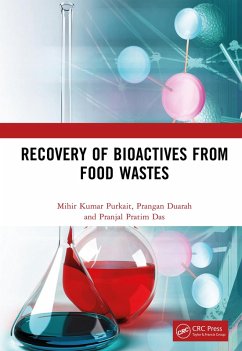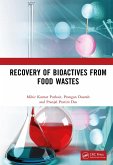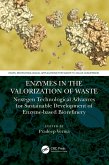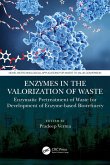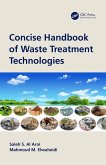Recovery of Bioactives from Food Wastes (eBook, PDF)


Alle Infos zum eBook verschenken

Recovery of Bioactives from Food Wastes (eBook, PDF)
- Format: PDF
- Merkliste
- Auf die Merkliste
- Bewerten Bewerten
- Teilen
- Produkt teilen
- Produkterinnerung
- Produkterinnerung

Hier können Sie sich einloggen

Bitte loggen Sie sich zunächst in Ihr Kundenkonto ein oder registrieren Sie sich bei bücher.de, um das eBook-Abo tolino select nutzen zu können.
This book is a concise presentation of important aspects involved in dealing with extraction and utilization of bioactive compounds from the food industry waste. It starts with a focus on the global scenario of food waste generation and potential of food waste in various industries. Thereafter, the various conventional and advanced extraction techniques are discussed to highlight on how to separate bioactive compounds from the food waste. The application of industrial food-waste derived bioactive compounds in various emerging sectors are highlighted.
Features:
Presents critical…mehr
- Geräte: PC
- mit Kopierschutz
- eBook Hilfe
![Recovery of Bioactives from Food Wastes (eBook, ePUB) Recovery of Bioactives from Food Wastes (eBook, ePUB)]() Mihir Kumar PurkaitRecovery of Bioactives from Food Wastes (eBook, ePUB)46,95 €
Mihir Kumar PurkaitRecovery of Bioactives from Food Wastes (eBook, ePUB)46,95 €![Agricultural and Kitchen Waste (eBook, PDF) Agricultural and Kitchen Waste (eBook, PDF)]() Agricultural and Kitchen Waste (eBook, PDF)45,95 €
Agricultural and Kitchen Waste (eBook, PDF)45,95 €![Biohydrometallurgical Recycling of Metals from Industrial Wastes (eBook, PDF) Biohydrometallurgical Recycling of Metals from Industrial Wastes (eBook, PDF)]() Hong HochengBiohydrometallurgical Recycling of Metals from Industrial Wastes (eBook, PDF)49,95 €
Hong HochengBiohydrometallurgical Recycling of Metals from Industrial Wastes (eBook, PDF)49,95 €![Enzymes in the Valorization of Waste (eBook, PDF) Enzymes in the Valorization of Waste (eBook, PDF)]() Enzymes in the Valorization of Waste (eBook, PDF)45,95 €
Enzymes in the Valorization of Waste (eBook, PDF)45,95 €![Enzymes in the Valorization of Waste (eBook, PDF) Enzymes in the Valorization of Waste (eBook, PDF)]() Enzymes in the Valorization of Waste (eBook, PDF)45,95 €
Enzymes in the Valorization of Waste (eBook, PDF)45,95 €![Fruits and Vegetable Wastes (eBook, PDF) Fruits and Vegetable Wastes (eBook, PDF)]() Fruits and Vegetable Wastes (eBook, PDF)104,95 €
Fruits and Vegetable Wastes (eBook, PDF)104,95 €![Concise Handbook of Waste Treatment Technologies (eBook, PDF) Concise Handbook of Waste Treatment Technologies (eBook, PDF)]() Saleh S. Al ArniConcise Handbook of Waste Treatment Technologies (eBook, PDF)82,95 €
Saleh S. Al ArniConcise Handbook of Waste Treatment Technologies (eBook, PDF)82,95 €-
-
-
Features:
- Presents critical discussion on various advancement in various extraction processes including future trends.
- Provides elaborative description of food waste sources and challenges associated with it.
- Highlights potential of bioactive compounds in various industries.
- Quantitatively discusses existing as well as new technologies/methodologies.
- Includes a separate chapter on pertinent policies of various countries.
This book is aimed at researchers and graduate students in chemical and food engineering, separation technology and bioactive compounds.
Dieser Download kann aus rechtlichen Gründen nur mit Rechnungsadresse in A, B, BG, CY, CZ, D, DK, EW, E, FIN, F, GR, HR, H, IRL, I, LT, L, LR, M, NL, PL, P, R, S, SLO, SK ausgeliefert werden.
- Produktdetails
- Verlag: Taylor & Francis eBooks
- Seitenzahl: 234
- Erscheinungstermin: 13. April 2023
- Englisch
- ISBN-13: 9781000862690
- Artikelnr.: 67495823
- Verlag: Taylor & Francis eBooks
- Seitenzahl: 234
- Erscheinungstermin: 13. April 2023
- Englisch
- ISBN-13: 9781000862690
- Artikelnr.: 67495823
- Herstellerkennzeichnung Die Herstellerinformationen sind derzeit nicht verfügbar.
Prangan Duarah is a doctoral research fellow at the Centre for the Environment in the Indian Institute of Technology, Guwahati. He worked on a research project at the Indian Institute of Technology, Bombay, before joining IIT Guwahati as a research fellow. He graduated from North Eastern Hill University in Shillong, India, with a B.Tech in Energy Engineering. His current field of study focuses on naturally derived bio-active compounds and green nanomaterial synthesis for various applications. He is a recipient of the prestigious Prime Minister's Research Fellowship (PMRF), which is given to the country's most outstanding research scholars as a token of encouragement to pursue their research. He has published several peer-reviewed articles in reputed international journals, along with several book chapters and one book.
Pranjal Pratim Das is currently a research scientist at the Department of Chemical Engineering, Indian Institute of Technology Guwahati, Assam, India. He received his M. Tech (2017) and B. Tech (2014) degree in Food Engineering and Technology from Tezpur (Central) University, Assam, India. His research work is purely dedicated to industrial wastewater treatment via electrochemical and advanced oxidation treatment techniques. His research focus is also related to the application of integrated (electrochemical and oxidation) water treatment processes for the remediation of specific unit operations of steel industry effluents. He is currently working in the treatment of cyanide and phenol contaminated wastewater of Tata Steel Industry, Jamshedpur India. He has published several peer-reviewed articles in reputed international journals, along with patents and book chapters. He is also a potential reviewer of the Journal of Water Process Engineering. Furthermore, he has fabricated and demonstrated many pilot plants for the green energy generations from wastewaters. He has worked extensively in various iron and steel making industries and has also delivered many pilot-scale set-ups to several water treatment facilities across the state of Assam, India for the treatment of toxic contaminated wastewaters.
of food waste. 1.2. Environmental effects and management approach. 1.3.
Valorization of food waste in various applications. 1.4. Conclusions.
References. 2. Current status and future trends of various food industry
waste processing for synthesis of bioactive compounds. 2.1. Introduction.
2.2. Bioactive compounds in various food industry waste. 2.3. Commercial
aspects. 2.4. Challenges and future perspective. 2.5. Conclusions.
References. 3. Technological advancement in the extraction of bioactive
compounds from food industry waste. 3.1. Introduction. 3.2. Conventional
methods for the extraction of bioactive compounds. 3.3. Progress in the
extraction of bioactive compounds. 3.4. Commercial utilization of the
extraction process. 3.5. Conclusions. References. 4. Recovery of bioactive
compounds from fruit and vegetable peel. 4.1. Introduction. 4.2. Recovery
of bioactive compounds from fruit peel. 4.4. Conclusions. References. 5.
Utilization of seeds for the synthesis of bioactive compounds. 5.1.
Introduction. 5.2. Characteristics and nutrient loss in fruit and vegetable
waste. 5.3. Bioactive compounds in fruit and vegetable seeds. 5.4.
Conclusions. References. 6. Sustainable green processing of various fruit
and vegetable pomace from the food industry for the synthesis of bioactive
compounds 6.1. Introduction. 6.2. Synthesis of bioactive compounds form
fruit and vegetable pomace. 6.3. Challenges and future perspectives. 6.4.
Conclusions. References. 7. Extraction of bioactive compounds from marine
by-products. 7.1. Introduction. 7.2. Bioactive element available in Marnie
by-products. 7.3. Technological advancement in the extraction process. 7.4.
Commercial aspects. 7.5. Challenges and future perspectives. 7.6.
Conclusions. References. 8. Extraction of bioactive compounds from tea,
coffee and wine processing waste. 8.1. Introduction. 8.2. Present status of
tea, coffee and wine production. 8.3. Extraction of bioactive compounds.
8.4. Conclusions.References. 9. Commercial aspects of bioactive compounds
extracted from food waste. 9.1. Introduction. 9.2. Utilization of bioactive
compounds in various industries. 9.3. Challenges and future trends. 9.4.
Conclusion. References. 10. Food waste management and valorization policies
of various countries. 10.1. Introduction. 10.2. International goals and
agreements. 10.3. Policies of various countries. 10.4. Major challenges.
10.5. Conclusions. References.
of food waste. 1.2. Environmental effects and management approach. 1.3.
Valorization of food waste in various applications. 1.4. Conclusions.
References. 2. Current status and future trends of various food industry
waste processing for synthesis of bioactive compounds. 2.1. Introduction.
2.2. Bioactive compounds in various food industry waste. 2.3. Commercial
aspects. 2.4. Challenges and future perspective. 2.5. Conclusions.
References. 3. Technological advancement in the extraction of bioactive
compounds from food industry waste. 3.1. Introduction. 3.2. Conventional
methods for the extraction of bioactive compounds. 3.3. Progress in the
extraction of bioactive compounds. 3.4. Commercial utilization of the
extraction process. 3.5. Conclusions. References. 4. Recovery of bioactive
compounds from fruit and vegetable peel. 4.1. Introduction. 4.2. Recovery
of bioactive compounds from fruit peel. 4.4. Conclusions. References. 5.
Utilization of seeds for the synthesis of bioactive compounds. 5.1.
Introduction. 5.2. Characteristics and nutrient loss in fruit and vegetable
waste. 5.3. Bioactive compounds in fruit and vegetable seeds. 5.4.
Conclusions. References. 6. Sustainable green processing of various fruit
and vegetable pomace from the food industry for the synthesis of bioactive
compounds 6.1. Introduction. 6.2. Synthesis of bioactive compounds form
fruit and vegetable pomace. 6.3. Challenges and future perspectives. 6.4.
Conclusions. References. 7. Extraction of bioactive compounds from marine
by-products. 7.1. Introduction. 7.2. Bioactive element available in Marnie
by-products. 7.3. Technological advancement in the extraction process. 7.4.
Commercial aspects. 7.5. Challenges and future perspectives. 7.6.
Conclusions. References. 8. Extraction of bioactive compounds from tea,
coffee and wine processing waste. 8.1. Introduction. 8.2. Present status of
tea, coffee and wine production. 8.3. Extraction of bioactive compounds.
8.4. Conclusions.References. 9. Commercial aspects of bioactive compounds
extracted from food waste. 9.1. Introduction. 9.2. Utilization of bioactive
compounds in various industries. 9.3. Challenges and future trends. 9.4.
Conclusion. References. 10. Food waste management and valorization policies
of various countries. 10.1. Introduction. 10.2. International goals and
agreements. 10.3. Policies of various countries. 10.4. Major challenges.
10.5. Conclusions. References.
